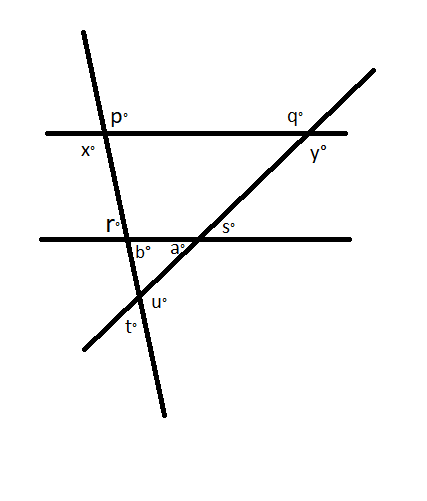
The two horizontal lines shown in the above figure are parallel to each other. Which of the following does not equal to 180°.

A.$\;\;\;\;\;\;\left( {p + r} \right)^\circ \\$
B.$\;\;\;\;\;\left( {p + t} \right)^\circ \\$
C.$\;\;\;\;\;\left( {q + s} \right)^\circ \\$
D.$\;\;\;\;\;\left( {r + s + t} \right)^\circ \\$
E.$\;\;\;\;\;\;\left( {t + u} \right)^\circ \\ $

Answer
577.5k+ views
Hint: First we’ll find the pairs of corresponding angles, vertically opposite angles, and linear angle pairs to get some equation in the given variables. Also using the exterior angle property of a triangle, we get an equation. Using those equations substituting in the equation required to find the sum of which angles measures 180°.
Complete step by step answer:
Given data: The two horizontal lines are parallel.

Using corresponding angles, because it is given that horizontal lines are parallel lines we can say
That, \[(x + r)^\circ = 180^\circ ...........(i)\]
And, \[(y + s)^\circ = 180^\circ ............(ii)\]
Using vertically opposite angles, we can say
That $x^\circ = p^\circ $
And, $q^\circ = y^\circ $
Substituting the value of x and y to the equation (i) and (ii), we get,
\[ \Rightarrow (p + r)^\circ = 180^\circ \]
\[ \Rightarrow (q + s)^\circ = 180^\circ \]
Using the exterior angle property of a triangle, i.e. exterior angle of a triangle is equal to the sum of the non-adjacent interior angles of the triangle. We can conclude
That \[(a + b)^\circ = u^\circ .............(iii)\]
Again Using vertically opposite angles, we can say
That $b^\circ = r^\circ $
And, $a^\circ = s^\circ $
Now substitute the value of a and b in equation(iii)
i.e. \[(r + s)^\circ = u^\circ \]
Now, using the linear pair i.e. sum of all angles lying on one side of a straight line measures 180°
i.e. \[(u + t)^\circ = 180^\circ ..........(iv)\]
Now substitute the value of u in equation(iv), we get,
i.e. \[(r + s + t)^\circ = 180^\circ \]
From the above equations, we can say that only (p+t)° does not measure 180°
therefore, option (B) is the correct option
Note: We know that in a triangle sum of all interior angles of a triangle measures 180° similarly the sum of all exterior angles of a triangle also measures 180°.
So here we can say
That \[(r + s + t)^\circ = 180^\circ \], that is giving us a similar equation as we’ve found in the above solution.
Complete step by step answer:
Given data: The two horizontal lines are parallel.

Using corresponding angles, because it is given that horizontal lines are parallel lines we can say
That, \[(x + r)^\circ = 180^\circ ...........(i)\]
And, \[(y + s)^\circ = 180^\circ ............(ii)\]
Using vertically opposite angles, we can say
That $x^\circ = p^\circ $
And, $q^\circ = y^\circ $
Substituting the value of x and y to the equation (i) and (ii), we get,
\[ \Rightarrow (p + r)^\circ = 180^\circ \]
\[ \Rightarrow (q + s)^\circ = 180^\circ \]
Using the exterior angle property of a triangle, i.e. exterior angle of a triangle is equal to the sum of the non-adjacent interior angles of the triangle. We can conclude
That \[(a + b)^\circ = u^\circ .............(iii)\]
Again Using vertically opposite angles, we can say
That $b^\circ = r^\circ $
And, $a^\circ = s^\circ $
Now substitute the value of a and b in equation(iii)
i.e. \[(r + s)^\circ = u^\circ \]
Now, using the linear pair i.e. sum of all angles lying on one side of a straight line measures 180°
i.e. \[(u + t)^\circ = 180^\circ ..........(iv)\]
Now substitute the value of u in equation(iv), we get,
i.e. \[(r + s + t)^\circ = 180^\circ \]
From the above equations, we can say that only (p+t)° does not measure 180°
therefore, option (B) is the correct option
Note: We know that in a triangle sum of all interior angles of a triangle measures 180° similarly the sum of all exterior angles of a triangle also measures 180°.
So here we can say
That \[(r + s + t)^\circ = 180^\circ \], that is giving us a similar equation as we’ve found in the above solution.
Recently Updated Pages
Master Class 12 Economics: Engaging Questions & Answers for Success

Master Class 12 Maths: Engaging Questions & Answers for Success

Master Class 12 Biology: Engaging Questions & Answers for Success

Master Class 12 Physics: Engaging Questions & Answers for Success

Master Class 8 Maths: Engaging Questions & Answers for Success

Class 8 Question and Answer - Your Ultimate Solutions Guide

Trending doubts
What is meant by exothermic and endothermic reactions class 11 chemistry CBSE

10 examples of friction in our daily life

One Metric ton is equal to kg A 10000 B 1000 C 100 class 11 physics CBSE

1 Quintal is equal to a 110 kg b 10 kg c 100kg d 1000 class 11 physics CBSE

Difference Between Prokaryotic Cells and Eukaryotic Cells

What are Quantum numbers Explain the quantum number class 11 chemistry CBSE




